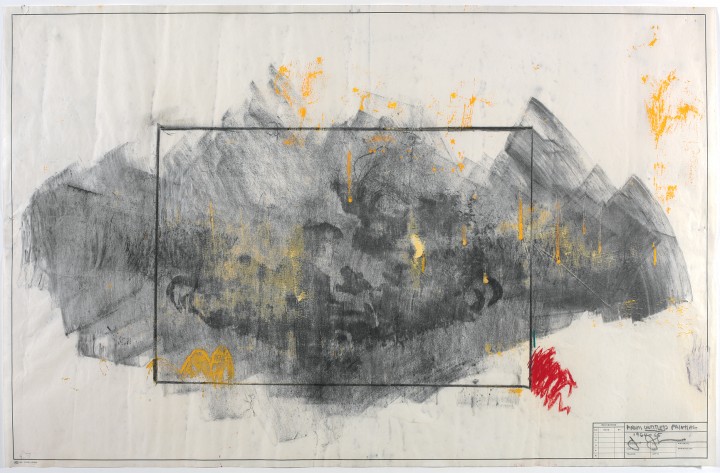Jennifer Padgett on Jasper Johns

Figure 1. Jasper Johns, From Untitled Painting, 1964-65
Charcoal, oil, and pastel on paper, 21 7/8 x 33 7/8 inches (55.6 x 86 cm)
Art © Jasper Johns/Licensed by VAGA, New York, NY
Jasper Johns
by Jennifer Padgett
Jasper Johns’s From Untitled Painting features an imprint of the artist’s face in the center of a sheet of drafting paper, framed by a rectangular outline. The drawing relates to his large untitled polyptych of 1964–65, now in the collection of the Stedelijk Museum, Amsterdam, which includes a similar image of a blurred facial trace. Johns uses a variety of techniques and materials in the painting, including stenciling, the addition of three-dimensional objects such as a broom, and the use of devices to make rainbow-like swipes within several panels. His drawing likewise includes a number of mark-making techniques, in particular imprinting, but it has a more focused and personal quality than the larger work. Although the drawing may be a preparatory study for the painting, it also could have been completed after the execution of the painting, a rather untraditional practice but one that Johns has frequently adopted.1 The completion of highly finished drawings after paintings—what Nan Rosenthal has called “‘postplay’ rather than foreplay”—indicates how thoroughly Johns has integrated a variety of mediums and processes within his overall practice.2 By taking one element of a painting and recasting it in a different medium—subtly modulated charcoal marks on paper—he meditated on the potential of the techniques available.
Imprints of body parts, such as the face or hands, appear in many of Johns’s paintings and drawings. He explores the potential of the body to create marks through direct contact with the canvas or paper, leaving a trace of its presence on the surface. Johns appears to have created the indexical mark of the face in From Untitled Painting by placing one side of his face on the paper and then turning or rolling it to imprint the other side. He likely covered his face with a light layer of baby oil before making the imprint and then rubbed charcoal across the sheet afterward to bring forth the traces of oil in darker tones.3
The application of charcoal in From Untitled Painting makes the image of the face visible, yet the unevenness of the sweeping strokes results in a highly illegible surface. While a solid rectangular outline cropped tightly around the imprint focuses the viewer’s gaze on the central section of the paper, the image in the circumscribed area remains muddled and ambiguous. The imprint of the face may read as a flayed skin stretched across the two-dimensional surface or, alternatively, as two separate faces meeting in the center. The former possibility evokes a visceral response to the flattened human form, while the latter insinuates a sense of intimacy and closeness. In both readings there is a strong appeal to the tactile sensibility of the viewer, with directness and touch as primary concerns.
Johns has engaged with the link between touching and looking throughout his long career, and he admires this quality in the works of other artists. For example, he was taken with a scene of bathers by Paul Cézanne because it “makes looking equivalent to touching.”4 The direct trace of the body through the imprint serves to develop this theme in Johns’s work, as the image registers the process of its making and the physical action involved. At the time this drawing was made, the body imprint also provided Johns with a means of establishing a personal statement in visual terms that departed from the model of Abstract Expressionist gesture, which had become moribund by the 1960s. The imprint of the artist’s face in From Untitled Painting, both revealed and obscured by a flurry of charcoal strokes, asserts his physical engagement with the work. Johns did not subvert the notion of the artist’s hand so much as literalize it by bluntly inserting his own body into the work, leaving a ghostly trace of his presence.
Notes
1. In an interview from 1989, Johns claimed that most of his finished drawings were made after the paintings of the same subject. Johns, in Ruth Fine and Nan Rosenthal, “Interview with Jasper Johns” (June 22, 1989), in The Drawings of Jasper Johns, by Nan Rosenthal et al. (Washington, DC: National Gallery of Art, 1990), 72.
2. Nan Rosenthal, “Drawing as Rereading,” ibid., 15.
3. He used this process in the series Studies for Skin, completed in 1962 as preparatory drawings for a sculptural work that was never executed. Jeffrey S. Weiss, “Painting Bitten by a Man,” in Jasper Johns: An Allegory of Painting, 1955–1965 (Washington, DC: National Gallery of Art, 2007), 13.
4. Grace Glueck, “The Twentieth-Century Artists Most Admired by Other Artists,” Art News 76 (November 1977): 87, quoted in Rosenthal et al., Drawings of Jasper Johns, 272.
Bios
Jasper Johns
Jennifer Padgett
